Related Research Articles

The Nez Percé are an Indigenous people of the Plateau who are presumed to have lived on the Columbia River Plateau in the Pacific Northwest region for at least 11,500 years.
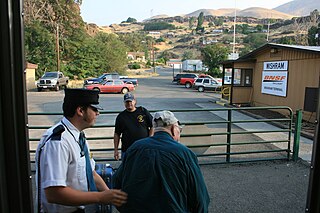
Wishram is an unincorporated community and census-designated place (CDP) in Klickitat County, Washington, United States. The population was 342 at the 2010 census, up from 213 at the 2000 census. The site of the historic Celilo Falls is nearby.

The Yakama are a Native American tribe with nearly 10,851 members, based primarily in eastern Washington state.
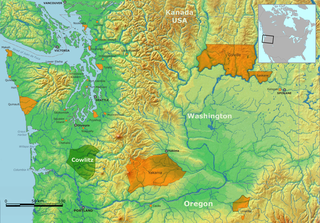
The term Cowlitz people covers two culturally and linguistically distinct indigenous peoples of the Pacific Northwest; the Lower Cowlitz or Cowlitz proper, and the Upper Cowlitz / Cowlitz Klickitat or Taitnapam. Lower Cowlitz refers to a southwestern Coast Salish people, which today are enrolled in the federally recognized tribes: Cowlitz Indian Tribe, Quinault Indian Nation, and Confederated Tribes of the Chehalis Reservation. The Upper Cowlitz or Taitnapam, is a Northwest Sahaptin speaking people, part of the Confederated Tribes and Bands of the Yakama Nation.

Chinookan peoples include several groups of Indigenous people of the Pacific Northwest in the United States who speak the Chinookan languages. Since at least 4000 BCE Chinookan peoples have resided along the Lower and Middle Columbia River (Wimahl) from the river's gorge downstream (west) to the river's mouth, and along adjacent portions of the coasts, from Tillamook Head of present-day Oregon in the south, north to Willapa Bay in southwest Washington. In 1805 the Lewis and Clark Expedition encountered the Chinook Tribe on the lower Columbia.

The Colville Indian Reservation is an Indian reservation in the northwest United States, in north central Washington, inhabited and managed by the Confederated Tribes of the Colville Reservation, which is federally recognized.
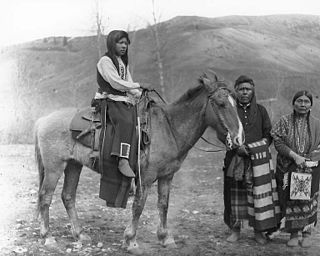
The Palouse are a Sahaptin tribe recognized in the Treaty of 1855 with the United States along with the Yakama. It was negotiated at the 1855 Walla Walla Council. A variant spelling is Palus. Today they are enrolled in the federally recognized Confederated Tribes and Bands of the Yakama Nation and some are also represented by the Colville Confederated Tribes, the Confederated Tribes of the Umatilla Indian Reservation and Nez Perce Tribe.

The Confederated Tribes of the Umatilla Indian Reservation are the federally recognized confederations of three Sahaptin-speaking Native American tribes who traditionally inhabited the Columbia River Plateau region: the Cayuse, Umatilla, and Walla Walla.

United States v. Washington, 384 F. Supp. 312, aff'd, 520 F.2d 676, commonly known as the Boldt Decision, was a legal case in 1974 heard in the U.S. District Court for the Western District of Washington and the U.S. Court of Appeals for the Ninth Circuit. The case re-affirmed the rights of American Indian tribes in the state of Washington to co-manage and continue to harvest salmon and other fish under the terms of various treaties with the U.S. government. The tribes ceded their land to the United States but reserved the right to fish as they always had. This included their traditional locations off the designated reservations.
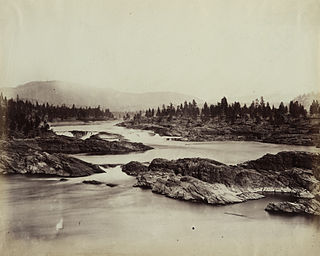
Kettle Falls was an ancient and important salmon fishing site on the upper reaches of the Columbia River, in what is today the U.S. state of Washington, near the Canada–US border. The falls consisted of a series of rapids and cascades where the river passed through quartzite rocks deposited by prehistoric floods on a substrate of Columbia River basalt. The river dropped nearly 50 feet (15 m), and the sound of the falls could be heard for miles away. Kettle Falls was inundated in 1940, as the waters of the reservoir Lake Roosevelt rose behind Grand Coulee Dam, permanently flooding the site.

Celilo Falls was a tribal fishing area on the Columbia River, just east of the Cascade Mountains, on what is today the border between the U.S. states of Oregon and Washington. The name refers to a series of cascades and waterfalls on the river, as well as to the native settlements and trading villages that existed there in various configurations for 15,000 years. Celilo was the oldest continuously inhabited community on the North American continent until 1957, when the falls and nearby settlements were submerged by the construction of The Dalles Dam.

Celilo Village, Oregon is an unincorporated Native American community on the Columbia River in northeastern Wasco County in the U.S. state of Oregon. It is near Lake Celilo, the former site of Celilo Falls; it is just south of the community of Wishram, Washington, across the Columbia River.

The Klickitat are a Native American tribe of the Pacific Northwest. Today most Klickitat are enrolled in the federally recognized Confederated Tribes and Bands of the Yakama Nation, some are also part of the Confederated Tribes of the Grand Ronde Community of Oregon.
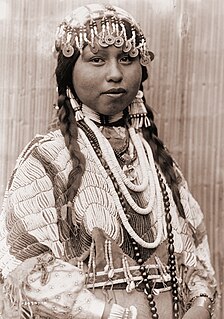
Wasco-Wishram are two closely related Chinook Indian tribes from the Columbia River in Oregon. Today the tribes are part of the Confederated Tribes of Warm Springs living in the Warm Springs Indian Reservation in Oregon and Confederated Tribes and Bands of the Yakama Nation living in the Yakama Indian Reservation in Washington.

A fish wheel, also known as a salmon wheel, is a device situated in rivers to catch fish which looks and operates like a watermill. However, in addition to paddles, a fish wheel is outfitted with wire baskets designed to catch and carry fish from the water and into a nearby holding tank. The current of the river presses against the submerged paddles and rotates the wheel, passing the baskets through the water where they intercept fish that are swimming or drifting. Naturally a strong current is most effective in spinning the wheel, so fish wheels are typically situated in shallow rivers with brisk currents, close to rapids, or waterfalls. The baskets are built at an outward-facing slant with an open end so the fish slide out of the opening and into the holding tank where they await collection. Yield is increased if fish swimming upstream are channeled toward the wheel by weirs.
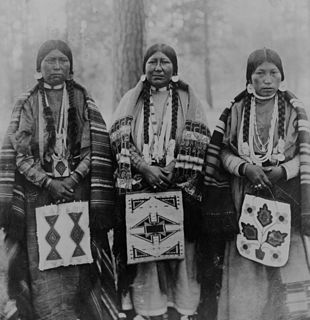
The Confederated Tribes of Warm Springs is a recognized Native American tribe made of three tribes who put together a confederation. They currently live on and govern the Warm Springs Indian Reservation in the U.S. state of Oregon.
United States v. Winans, 198 U.S. 371 (1905), was a U.S. Supreme Court case that held that the Treaty with the Yakima of 1855, negotiated and signed at the Walla Walla Council of 1855, as well as treaties similar to it, protected the Indians' rights to fishing, hunting and other privileges.

The Tenino people, commonly known today as the Warm Springs bands, are several Sahaptin Native American subtribes which historically occupied territory located in the North-Central portion of the American state of Oregon. The Tenino people included four localized subtribes — the Tygh or "Upper Deschutes" divided in Tayxɫáma, Tiɫxniɫáma and Mliɫáma, the Wyam (Wayámɫáma) (Wayámpam) or "Lower Deschutes", also known as "Celilo Indians", the Dalles Tenino or "Tinainu (Tinaynuɫáma)", also known as "Tenino proper"; and the Dock-Spus (Tukspush) (Takspasɫáma) or "John Day."
The Columbia River Inter-Tribal Fish Commission (CRITFC) is a fishery resource for the treaty tribes of the Columbia River. Under the treaty, the native tribes, The Nez Perce Tribe, Warm Springs Reservation Tribe, and Umatilla Indian Reservation Tribe, have to the right to fish in the Columbia River, which means their fishery must be reserve and protect.
References
- ↑ Hedburg, David-Paul Brewster (2017). "As Long as the Mighty Columbia Flows": The Leadership & Legacy of Wilson Charley, a Yakama Indian Fisherman. ProQuest LLC. p. 53.
- ↑ Fisher, Andrew. "Celilo Fish Committee (1935 - 1957)". www.oregonencyclopedia.org. Retrieved 2021-03-16.
{{cite web}}: CS1 maint: url-status (link) - ↑ Claims, United States Court of; Bernhardt, Audrey (1964). Cases Decided in the United States Court of Claims ... with Report of Decisions of the Supreme Court in Court of Claims Cases. The Court. pp. 147–148.
- ↑ Columbia River Basin Fish and Wildlife Program--salmon recovery : hearing before a subcommittee of the Committee on Appropriations, United States Senate, One Hundred Fourth Congress, first session : special hearing--Office of Management and Budget, Bonneville Power. Washington: U.S. Government Printing Office. 1953. p. 1532. doi:10.5962/bhl.title.45850. ISBN 0-16-053676-6.
- ↑ "Celilo Village History". www.winniechu.com. Retrieved 2021-03-17.
- 1 2 3 Dupris, Joseph C. (2006). The Si'lailo way : Indians, salmon, and law on the Columbia River. Kathleen S. Hill, William H. Rodgers. Durham, N.C.: Carolina Academic Press. ISBN 1-59460-085-6. OCLC 60454899.
- ↑ "Celilo Fish Committee (1935 - 1957)". www.oregonencyclopedia.org. Retrieved 2021-03-17.
- 1 2 Dupris, Joseph C.; Hill, Kathleen S.; Rodgers, William H. Jr. (2014). The Si'lailo Way: Indians, Salmon and Law on the Columbia River. Durham, North Carolina: Carolina Academic Press. p. 294. ISBN 978-1-59460-085-2.
- ↑ Walton, J. (2007-06-01). "KATRINE BARBER. Death Of Celilo Falls. (The Emil and Kathleen Sick Lecture-Book Series in Western History and Biography.) Seattle: University of Washington Press in association with the Center for the Study of the Pacific Northwest. 2005. Pp. xi, 258. $22.50". The American Historical Review. 112 (3): 865–866. doi:10.1086/ahr.112.3.865-a. ISSN 0002-8762.
- ↑ Walton, J. (2007-06-01). "KATRINE BARBER. Death Of Celilo Falls. (The Emil and Kathleen Sick Lecture-Book Series in Western History and Biography.) Seattle: University of Washington Press in association with the Center for the Study of the Pacific Northwest. 2005. Pp. xi, 258. $22.50". The American Historical Review. 112 (3): 865–866. doi:10.1086/ahr.112.3.865-a. ISSN 0002-8762.
- ↑ Walton, J. (2007-06-01). "KATRINE BARBER. Death Of Celilo Falls. (The Emil and Kathleen Sick Lecture-Book Series in Western History and Biography.) Seattle: University of Washington Press in association with the Center for the Study of the Pacific Northwest. 2005. Pp. xi, 258. $22.50". The American Historical Review. 112 (3): 865–866. doi:10.1086/ahr.112.3.865-a. ISSN 0002-8762.
- ↑ Walton, J. (2007-06-01). "KATRINE BARBER. Death Of Celilo Falls. (The Emil and Kathleen Sick Lecture-Book Series in Western History and Biography.) Seattle: University of Washington Press in association with the Center for the Study of the Pacific Northwest. 2005. Pp. xi, 258. $22.50". The American Historical Review. 112 (3): 865–866. doi:10.1086/ahr.112.3.865-a. ISSN 0002-8762.
- ↑ Barney, Amanda (2012-03-23). "One Fish or Two Fish, Red Fish or Blue Fish". Conservation Biology. 26 (2): 372–373. doi: 10.1111/j.1523-1739.2012.01832.x . ISSN 0888-8892.
- ↑ "Death of Celilo Falls".
- ↑ "Indians Fish at Celilo Falls". www.oregonhistoryproject.org. Retrieved 2021-03-17.